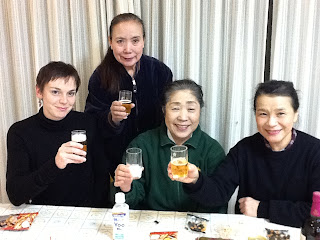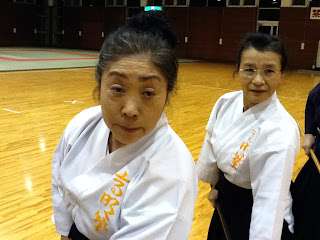Sekiguchi Soke has won a heart in Tokyo 18/02/2013
Monday 25 February 2013
Saturday 23 February 2013
Friday 22 February 2013
Thursday 21 February 2013
Report from Robert Sedunary A.K.A. Kensei Sekiguchi for the 36th Nippon budokan 11-02-2013
Komei
Juku Iaijutsu.Katsuura shugyou training
36th Nippon budokan Kobudokyokai Embu Taikai.Himeji
11.2.2013
2013 has got off to a good
start for Komei Juku Iaijutsu. Firstly with our regular shugyou keiko at the
Nippon budokans Kenshu centre at Katsuura this February and then following up
with The Nippon budokan’s Kobudokyokai Embu at Himeji. Nothing good has ever
come from a lack of effort and it’s fair to say we worked hard toward a good
demonstration to which I feel we really did do something good. Dai Sempai
Noguchi Sensei was ever vigilant over the performance and the training that led
up to it, keeping us all aware of the high standard we must display if we were
to succeed. A good mix of nationalities at Katsuura provided an excellent
chance to expand ourselves each day. Japanese, Spanish, English, French,
Austrian, Korean etc.. To the uninitiated, communication would seem hopeless
with such a group, however to the credit of our interpreters and our own will
to understand, we did very well this year. “Isshin” is what it is, and this is
a large part of Sekiguchi sensei’s teachings when we look at the moral ethos
associated with budo. It’s a wonderful thing to see at work especially across a
mixed group of nationalities and languages. Training was as ever very
difficult, starting each day at 5.00am and not finishing until 10.00pm each
evening. Just enough time for a quick shower and then off to bed for a very
short sleep, waking to a cold morning each day to do it again. The staff at the
Kenshu centre are as always key to a good seminar like ours and once again they
excelled in there tasks each day. The members of the Kenshu centre were always
friendly and caring, punctual and supportive. Kookiesan and his staff in the
kitchen are to receive special mention for once again providing us with
wonderful meals morning, noon and night. A big thanks to you Cookiesan and
staff. Shimizu Sensei although not training with us this year did make an
appearance, much to our surprise, to award some members of the group with a new
art name. The intention, to encourage those members to pass forward all that
she has imparted to them over the years, and to take forward her beautiful
naginata movements into
the future. A great honour
and a great responsibility comes with such a name, so good luck to those
members, and well done. Each day we worked with both sword and naginata to
expand our knowledge of both weapons. Sekiguchi sensei is very quick to point
out to us that good Iai and in fact good budo comes from a good sense of awareness.
Weapons vary in many ways so we must remain aware if we are to develop our
skills with these weapons, in defence as well as in kata or kumitachi. As
always Embu is a very serious matter when it comes time to do it, especially at
the Nippon budokan in Japan. Jukuchou has in the past likened it, as an analogy
to doing battle. Obviously it is not real battle, but you get the idea. So you’ve
got to step up. It’s a true test of the nerves and ones endurance, starting
with days of endless rehearsal all leading up to the moment when you first draw
your sword. I’m sure everyone feels the same at that one special moment. Its
said one can train and hone ones skills in the dojo for 20yrs or more to then
simply have it all fall apart the day you need it most. In my opinion, only
Embu of this kind can fully provide one with this strengthening of character
and will that one needs to survive in this tough world of ours..Embu is far
more than just a performance.
From a back room at the
Budokan we watched the other groups perform there routines as the time led up
to our six minutes. A very good standard I thought from all the groups I was
lucky enough to see. This year I thought there was a good feeling of
professionalism among our group and without so much as a fuss we walked on the
stage and gave what I thought was one of the day’s best performances. In all
fairness I didn’t see all the other groups, but we were good. I think this
years “most improved” award goes to Sonoko Sensei from Portland America. Sonoko
sensei’s naginata was definitely a level up on what I saw last time we trained
together and her understanding of Iaijutsu as a whole was clearly up on last
year. Sonoko Sensei was better focused with sharper kata and greater stamina
and confidence, impressively managing the chudan hayanuki in just a few days to
perform it at Embu. Very well done. Offcourse all the members of the
international group deserve praise for there efforts that made the whole
experience a pleasant and rewarding one. However, none other than Grandmaster
Sekiguchi Sensei himself deserves praise more. What more can I say…A great
teacher, and a great man.. He is, great.
Sekiguchi Kensei.
Komei Juku Iaijutsu
Tuesday 19 February 2013
Townsville Seminar Komei Juku 2013
Dates for 2013 seminar in Townsville as follows:
Sensei leave Tokyo 16th June 2013
Arrives Townsville 17th June 12n
Training 18th 9am - 5pm
Training 19th 9am - 5pm
Training 20th 2pm -8pm
Training 21th 9am - 5pm
Training 22th 9am - 5pm
Training 23th 9am - 5pm
Depart Townsville 24th June 7am
Costs are: $350 or $100 per day for students travelling to Townsville
Local Student: $450 or $120 per day
contact: info@komei-juku.com.au or your local instructor for more details!
Sensei leave Tokyo 16th June 2013
Arrives Townsville 17th June 12n
Training 18th 9am - 5pm
Training 19th 9am - 5pm
Training 20th 2pm -8pm
Training 21th 9am - 5pm
Training 22th 9am - 5pm
Training 23th 9am - 5pm
Depart Townsville 24th June 7am
Costs are: $350 or $100 per day for students travelling to Townsville
Local Student: $450 or $120 per day
contact: info@komei-juku.com.au or your local instructor for more details!
Saturday 16 February 2013
Video footage from Japan of Sekiguchi Soke
Here is some very nice footage from Japan of Sekiguchi Soke and his Japanese and internation students.
http://
Friday 15 February 2013
Thursday 7 February 2013
Sunday 3 February 2013
2013 open day 2PCYC Townsville
Komei Juku. Muso Jikiden Eishin Ryu Iaijutsu - Classical Japanese Swordsmanship
www.komei-juku.com.au
Well, after of morning of setting up and 3 hours of PCYC
open day we had a great day. Thank you to everyone who helped out. A big
thankyou to the staff of the PCYC and
4T0FM Radio who did a great job promoting us which helped make this all possible. Thank you to the students
who volunteered to help with the demonstration a great effort by all.
Subscribe to:
Posts (Atom)



















































